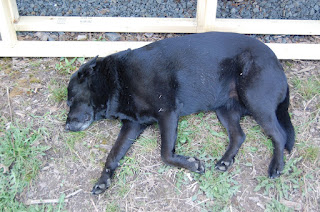The greenhouse is an essential component of a farm. It is where the newly seeded plants are placed and where they will germinate and begin to sprout. The greenhouse provides a warm and secure environment for the newly developing plants. Though certain crops are directly seeded into the soil in prepared beds, most plants start their life in a greenhouse. In addition to protection from the elements, in the greenhouse the farmer can control how much water the plants will receive. The greenhouse provides the new plants with the warmth that enhances their growth and development. As a new farm, Z Food Farm needed a greenhouse. Over the course of a couple of weeks, and with help from Farmer Matt, David erected his greenhouse. A few pictures were presented in the previous posting. In this post are pictures showing the process of building the greenhouse.
In the previous post it was mentioned that the posts needed to be hammered into the ground. This is that process. David is using a spacing board that was sent by the manufacturer of the greenhouse. This ensures that the posts are evenly spaced.

Also mentioned previously was that the hoops came in three parts and had to be assembled. Here are the pieces of the hoops.

Here is the completed frame of the greenhouse. If you click on the picture to enlarge it you will see the cross bars running along the top, corner braces, and wood running along the bottom of the posts. This is all intended to provide support to the structure to help hold the greenhouse together.

In this picture David is digging a hole into which will be place a post. Four posts are embedded in the ground. 2x4 lumber will then be placed on top of the posts. These 2x4's provide the foundation upon which the end walls will be built. Along the ground you can see heavy duty landscaping fabric- this will suppress the growth of weeds.
 Here you can see the frame one of the end walls. You can see the 2x4's along the bottom and how the top pieces are attached to the metal of the last hoop. You can also see rock that has been placed on top of the fabric. This was done to help, somewhat, level the ground.
Here you can see the frame one of the end walls. You can see the 2x4's along the bottom and how the top pieces are attached to the metal of the last hoop. You can also see rock that has been placed on top of the fabric. This was done to help, somewhat, level the ground.
After receiving assistance from Farmer Matt in framing one end wall, Farmer David is beginning the process of putting up the frame for the other end wall.

Having completed the second frame, the next step in the process was putting plywood onto the frame. In this picture David is using a reciprocating saw to cut off and round off the plywood. The shiny, metal object that you also see are vents that will open up when the heating unit and fan are in operation.

In this picture the end wall has been primed in preparation of being painted. Also, on the left side of the picture, about half way up you can see some wood that is running the length of the greenhouse. This will be used to help secure the plastic to the greenhouse.

And here you can see the truly green, greenhouse. You can also see the fan that will be used to help with both the heating and the cooling of the greenhouse, depending on what is needed. You can also see that the door has been put in place. In some ways getting the door situated so that it would close and stay latched was one of the more frustrating aspects of the entire process.

Here it is, one greenhouse. Actually, at this stage there are still a number of tasks yet to be completed, but you have a general sense of what the finished project looks like.

Here is a picture of the interior of the greenhouse.

In this shot David, with the help of Farmer Dean (he no longer farms, but once a farmer, always a farmer), is beginning the first of various final stages. Here he is putting on pieces of wood that will help hold the plastic on the end walls.

Putting the greenhouse up was a long and arduous process. Actually, the notion of long and arduous sums up most aspects of the life and lifestyle of a farmer. To be a farmer, in particular a small scale, independent family farmer requires commitment, dedication, and a love for what you are doing. It's been said here before, and will be said again, when you go to a farmers' market take the time to get to know the farmer you are buying from. Ask them questions about the food you are buying. And remember to thank them.
Peace, hopefulness, and healthy eating to all.








